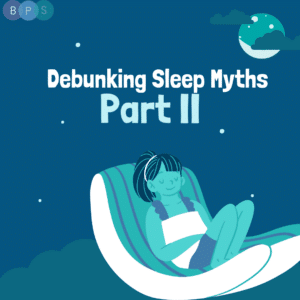Tips and Tricks to Optimize Your Sleep
As promised, we could not leave you dark from our last blog post on sleep myths, and we are back with some tips and tricks to optimize sleep!
Thankfully, a significant amount of research has taken place to develop methods to enhance our ability to fall asleep and get the most out of catching some Z’s! This research is known as CBT-I or Cognitive Behavioral Therapy-Insomnia.
CBT-I is the most effective nonpharmacological treatment for chronic insomnia. In just a few sessions, it can produce lasting results that are equivalent to sleep medication, without the side effects and with less chance for relapse (Rossman, 2019).
There are five key components to CBT-I: Sleep Consolidation, Stimulus Control, Cognitive Restructuring, Sleep Hygiene, and Relaxation Techniques.
Sleep Consolidation
Sleep consolidation, also known as sleep restriction, brings us back to the first myth that we addressed, “If you’re having trouble falling asleep, stay in bed until you can.” Oftentimes when people are having a hard time falling asleep, they lay awake waiting to get tired. This leaves them spending more time in bed awake than asleep, which can be counterproductive and super frustrating! Instead, it’s recommended that you don’t get into bed until you are feeling tired, so that by the time that you get into bed you can fall asleep and stay asleep. In short, the suggestion is don’t crawl in bed until you’re good and tired!
Stimulus Control
The next component of CBT-I is stimulus control. Experts stress that the bed should specifically be a place for sleep, and not used for reading, watching TV, talking on the phone, eating, drinking, or working. While it can be tempting to spend all day cozy in our beds, in order to get a great night’s sleep, it is important that our bed is not associated with anxiety and wakefulness or anything but rest!
Cognitive Restructuring
When we are having a hard time falling asleep, our minds can tend to spiral. You might think, “I should have fallen asleep two hours ago! If I don’t fall asleep soon, I’ll be a wreck tomorrow and never pass my exam.” In order to change our sleep patterns, it’s important to change these thoughts into more positive ones, such as, “Even if it takes me longer to fall asleep tonight, I will still get through tomorrow.”
Sleep Hygiene
Sleep hygiene refers to a set of guidelines that promote healthy sleep. These are often the guidelines that we hear about but might be more hesitant to enforce. These include: Go to bed at the same time each night and wake up at the same time each day; refrain from eating and drinking alcohol 2 to 3 hours before bed; avoid exposure to bright light 2 hours before bedtime; avoid caffeine in the afternoon and evening; decrease exposure to screens 1 to 2 hours before bed. While you might be reading through this list thinking, “what a pain! Do I have to?” you aren’t alone. However, changing these habits have been proven to be worth it when it comes to improving our sleep.
Relaxation Techniques
The last component is relaxation techniques that can be done before bed. These techniques include, but are not limited to, breathing exercises, mindfulness, meditation and more. Box breathing is a personal favorite. This involves repeating the pattern of breathing in for 4 seconds, holding for 4 seconds, breathing out for 4 seconds, and holding for 4 seconds.
Hopefully CBT-I has restored your faith in your future quality of sleep and has debunked the sleep myths we discussed in our prior post.
Source:
Robbins, R., Grandner, M. A., Buxton, O. M., Hale, L., Buysse, D. J., Knutson, K. L.,
Patel, S. R., Troxel, W. M., Youngstedt, S. D., Czeisler, C. A., & Jean-Louis, G. (2019). Sleep myths: an expert-led study to identify false beliefs about sleep that impinge upon population sleep health practices. Sleep health, 5(4), 409–417. https://doi.org/10.1016/j.sleh.2019.02.002
Rossman J. (2019). Cognitive-Behavioral Therapy for Insomnia: An Effective and
Underutilized Treatment for Insomnia. American journal of lifestyle medicine, 13(6), 544–547. https://doi.org/10.1177/1559827619867677
